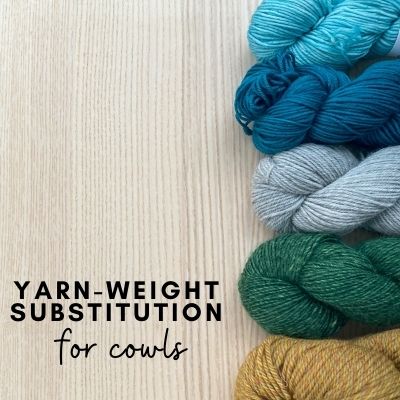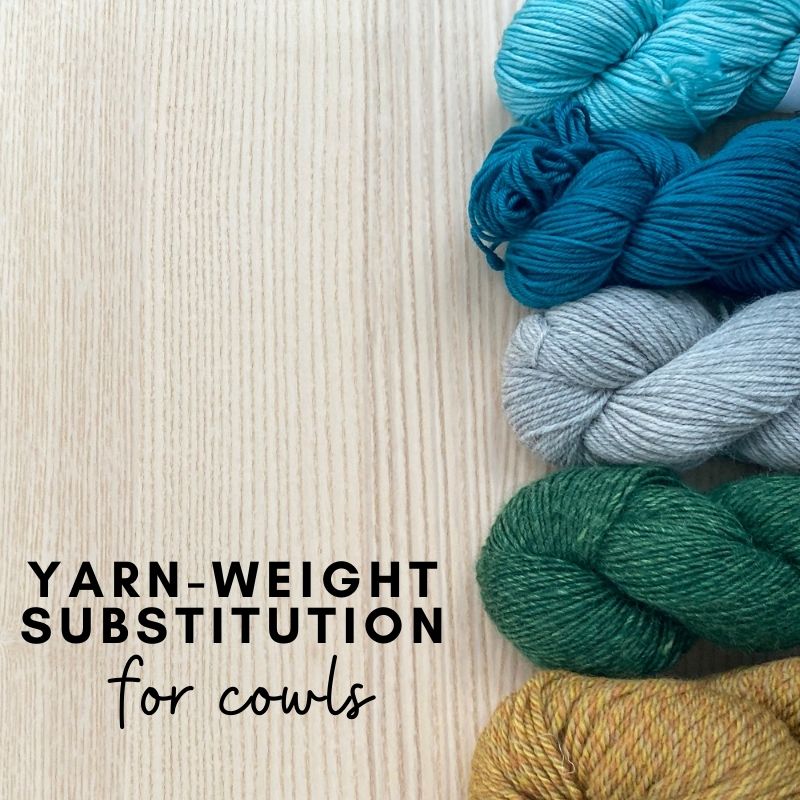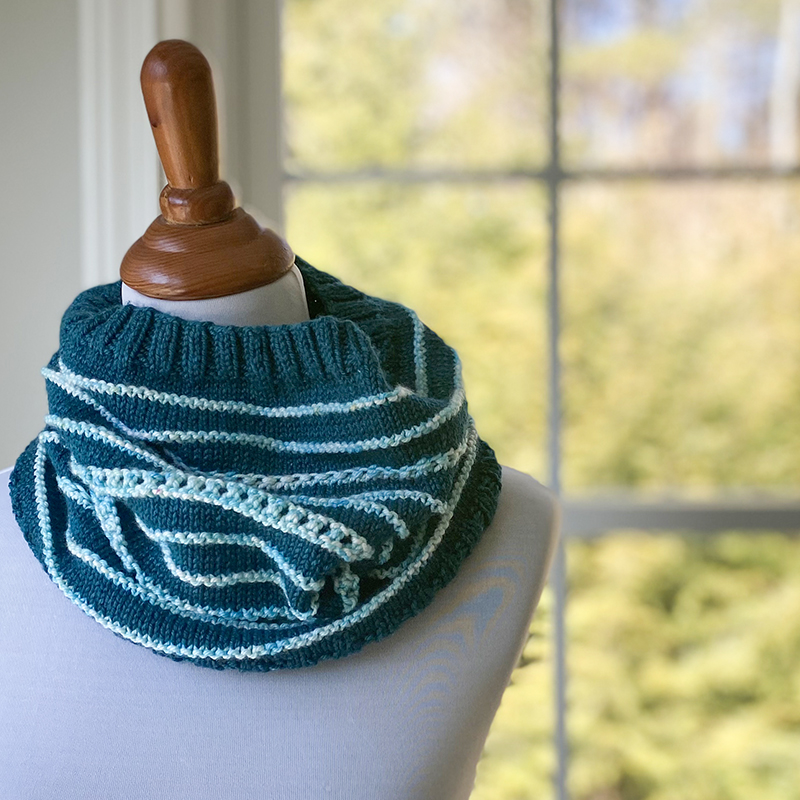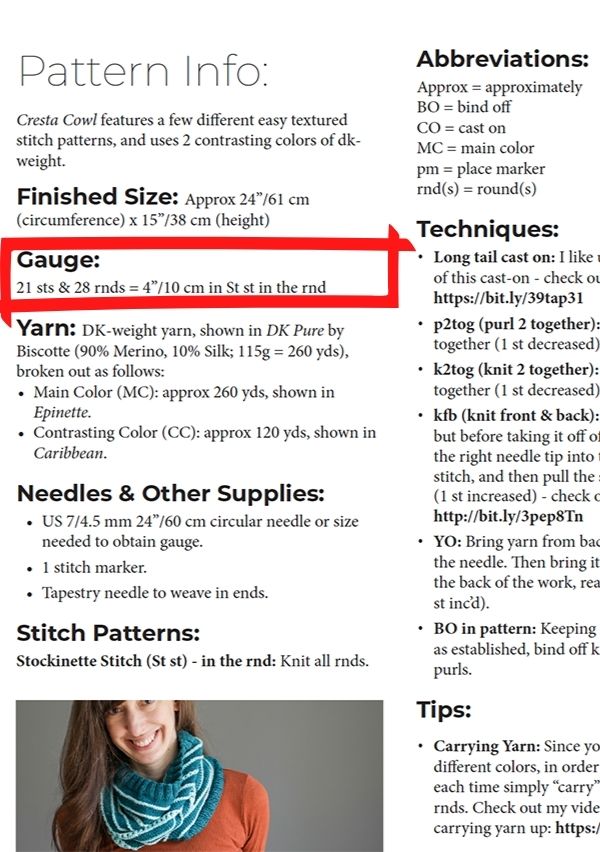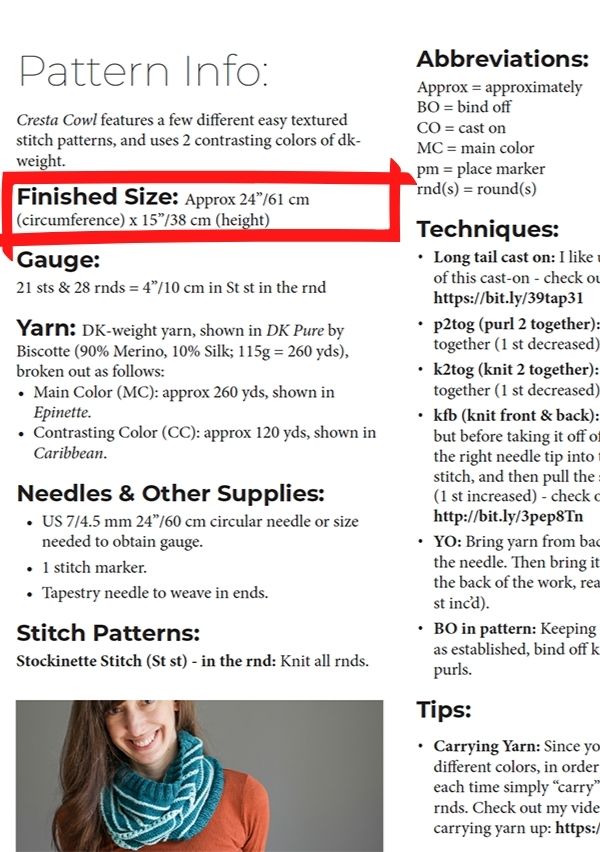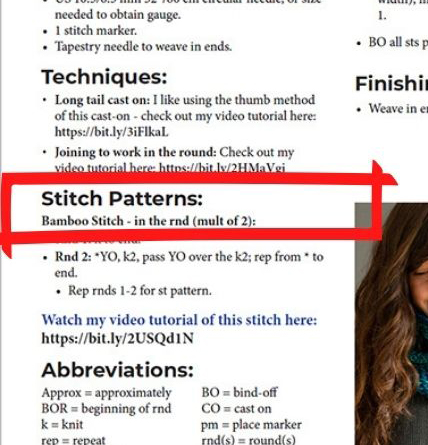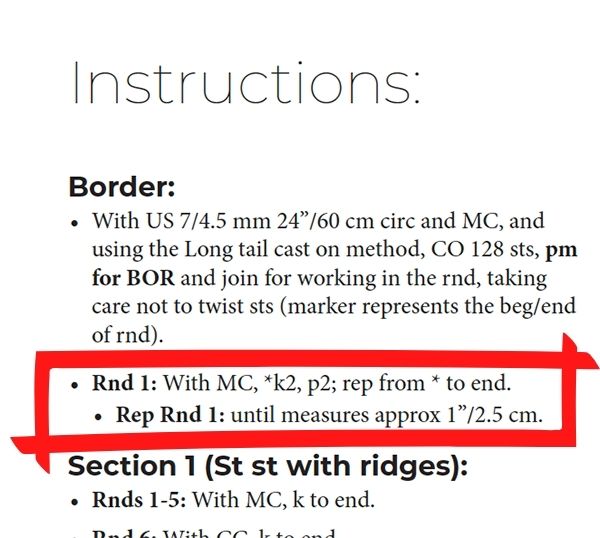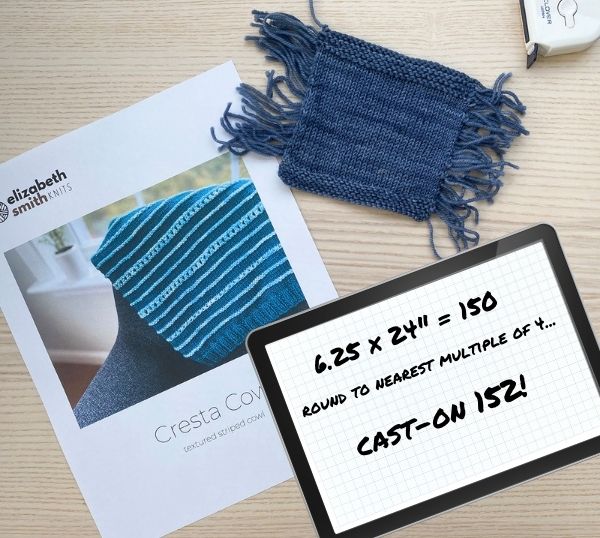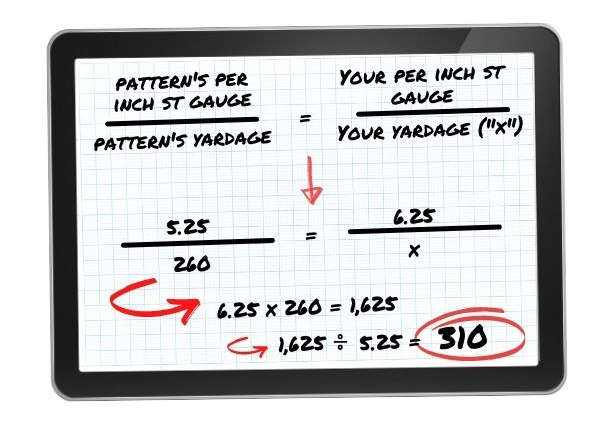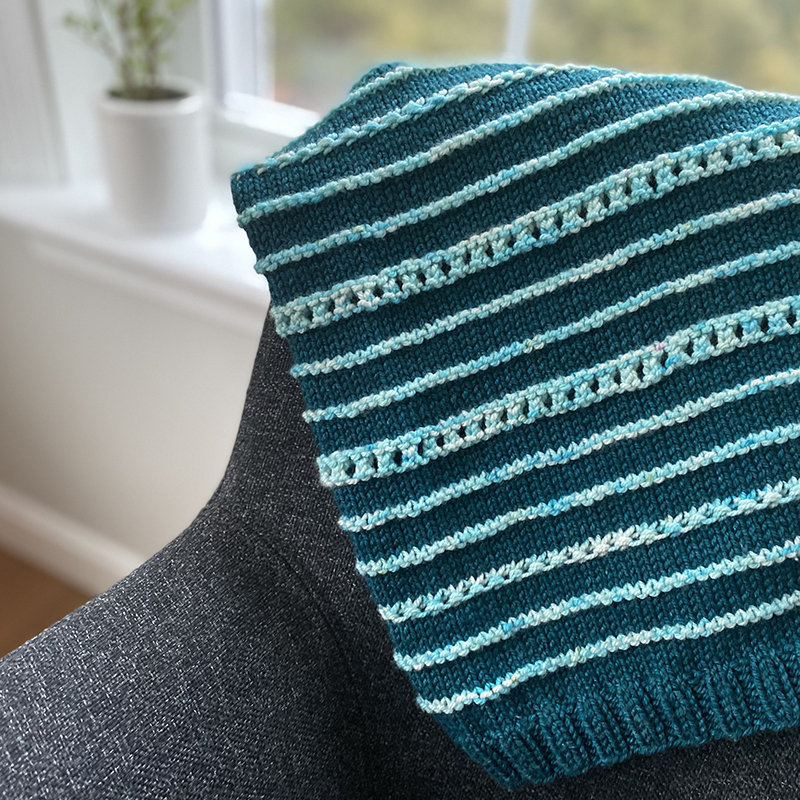Let’s say you just saw a cowl pattern that you absolutely love, but just wish it used a different yarn weight. For example, let’s say the pattern calls for DK-weight but you really want to use Fingering, or maybe Bulky. Can you substitute one yarn weight for another? You can! But it will likely mean casting on a different amount of stitches in order to get the correct finished dimensions (assuming you can’t get the pattern gauge with your desired yarn), and often using a different amount of yardage than what is called for. In this blog post I will explain the 4 pieces of information you will need to figure this out, and the calculations you will need to make, for a simple cowl pattern.
Although it’s definitely possible to substitute yarn weight in garment patterns as well, it’s a bit trickier as there are a lot more factors to consider. So this post will be the simpler version and I’ll just be focusing on cowls, using my Cresta Cowl as the example – but the tips I suggest can be applied to other pieces too.
In order to come up with your cast-on information and ballpark yardage amount, you will need 4 pieces of information:
- Your yarn’s stitch gauge
- The finished cowl circumference
- The stitch pattern used in the cowl
- The pattern’s listed stitch gauge
Steps 1-4 below will explain how to gather this information. And then I will show how to calculate your cast-on amount and approximate yardage needed.
Step 1: Swatch with your chosen substitute yarn:
The first thing is to determine what your gauge will be with your chosen yarn. You would typically do this anyway, even if you were not substituting yarn weight, but sometimes with cowl patterns people will omit this step because finished dimensions aren’t as critical as it is with garments. But if you want to use a completely different yarn weight than what is recommended in the pattern, you should definitely swatch.
What needle should you swatch with? See what is recommended on the yarn label as a starting point. Or, pick a needle size based on the yarn weight. For example, for this blog post example, I’m swatching with Manos del Uruguay’s fingering-weight Alegria. Because it’s a fingering-weight, I’ve swatched it on a size US 5 since I typically would use around that size for that weight yarn for a cowl. When in doubt, check the yarn label or, look on Ravelry to see what size needle others have used with that particular yarn.
What stitch pattern should you use when swatching? Find where your gauge is listed in the Pattern Information page to see what stitch pattern you should be swatching in. In my Cresta Cowl, it’s stockinette stitch in the round – see highlighted below in my Pattern Info screenshot (for tips on swatching in the round, click here).
Step 2: Measure your Gauge Swatch:
Measure your swatch to see how many stitches you are getting over 4″ (if you need help with this, check out my tutorial on how to measure your swatch). In my example below, I am getting 25 stitches over 4″ in Stockinette stitch in the round.
Now break that down to how many stitches per inch. So for my example, 25 divided by 4 = 6.25. So I’m getting 6.25 stitches to 1″.
Step 3: Find the “Finished Circumference” of your cowl:
In my patterns, it’s usually one of the first headers on my Pattern Info page. As you can see below, for my Cresta Cowl, the circumference is 24″:
Step 4: Determine the “multiple” your cast-on amount needs to be:
Depending on the stitch patterns used in your pattern, your cast-on amount will likely need to be a multiple of something – whether it’s a multiple of 2, 4, or something else. How do you figure out what this multiple might be? Here are 2 examples of places to look for it:
Option 1: If your cowl is using a unique stitch pattern (so something other than Stockinette stitch or Garter stitch), often it will be listed on the Pattern Info page and often it will say what the multiple will be. An example of this is my Crispy Cowl. I use a Bamboo stitch and, as you can see in the screenshot below, I note that this stitch pattern needs to be in a multiple of 2 (abbreviated “mult of 2”):
Option 2: If the stitch pattern is not unique, or the multiple is not listed, then you have to do a little investigating based on the pattern instructions. The first place to look is the stitch pattern used right after the cast-on. Let’s look at the beginning instructions of my Cresta Cowl…
So right after cast-on, you’re instructed to work the first row in “k2, p2” to the end. So this means your cast-on amount should be a multiple of 4 in order for this stitch pattern to work out. To double-check this, I’ll take the cast-on amount listed in the pattern (which in this case is 128) and divide that by 4 to make sure it is indeed a multiple of 4 – and it is! So mystery solved, the cast-on amount should be a multiple of 4. Depending on the pattern you are working on it may take a bit more investigating as you look over all of the pattern instructions. If it’s one of my patterns, feel free to email me if you need help!
Now that you have figured out your own yarn’s stitch gauge, your cowl’s circumference and your stitch pattern multiple, you can move on to doing the actual calculations!
How to calculate your cast-on amount:
Get your calculator out and let’s do some math…
Take your per inch stitch gauge (figured out in step 2) and multiple it by your cowl’s finished circumference (figured out in step 3). Then round it up or down based on the multiple your cast-on amount needs to be in.
Let’s use my Alegria swatch as our example again. So as you remember from step 2, my per inch stitch gauge was 6.25. And as we learned in step 3, my finished cowl’s circumference is 24″. So 6.25 x 24 = 150. Is 150 divisible by 4? When I divide 150 by 4 I get 37.5, so it’s not a multiple of 4 (since 37.5 is not a whole number). So that means we either need to go up or down by 2 – I’d rather my cowl be a tiny bit bigger than smaller, so I will round up to 152. I divide that by 4 just to make sure and it’s 38 – a whole number. So 152 is divisible by 4 and so it will be my cast-on amount!
How to figure out how much yarn you will need:
Here’s one last factor to think about. If you change the yarn-weight, you’ll also change the yardage amount needed. If the yarn is thinner than what the pattern calls for, you’ll likely need more yardage. If it’s thicker, you’ll likely need less yardage. There are in-depth ways that I figure out yardage amounts for patterns, but for the sake of simplicity, I will teach you my very basic approximate way that I would often use when I worked at a yarn shop and would help customers with this question. It uses some simple algebra, and I will stress – this is approximate. But it will give you a ballpark figure:
Take YOUR per inch st gauge and multiple it by the yardage amount listed in the pattern. Then take this number and divide it by the PATTERN per inch stitch gauge. Round this number up and this is the approximate amount of yardage you will need for your yarn .
And in case you’re a visual learner like me, here is how that cross algebra formula looks (it’s like you’re in math class again and need to show your work!):
What about row gauge and cowl height?
Because cowls such as Cresta Cowl are knit in the round, the most important measurement is the circumference as that can’t be changed while you knit (since it’s your cast-on amount). The height/length, affected by your row gauge, is more easily tweaked as you knit – depending on the pattern, you can just work more or less rows to get the correct finished height.
In conclusion…
I hope going over these yarn-weight substituting tips has been helpful! As I mentioned in the beginning, these tips are just the very basic calculations when sub-ing for simple cowl patterns but hopefully showing you a little behind the scenes math will help you the next time you want to play around with yarn-weight substitution! One other thing to mention…changing yarn weight can also have an affect on drape and so it’s just another factor to consider when making substitutions. Reach out if you have any questions!

